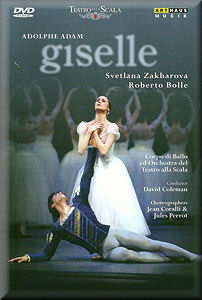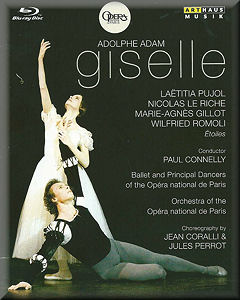 |
 |
|


alternatively
MDT
AmazonUK
AmazonUS |
Adolphe ADAM (1803-1856)
Giselle Ballet pantomime in two acts (1841) [105:00]
Choreography by Jean Coralli and Jules Perrot
Choreographic restaging by Yvette Chauviré
Restaged by Florence Clerc
 Svetlana Zakharova - Giselle
Svetlana Zakharova - Giselle
Roberto Bolle - Prince Albrecht
Vittorio D’Amato - Hilarion
Annalisa Masciocchi - Mother
Marta Romagna - Myrtha
Flavia Vallone - Princess Bathilde
Francisco Sedonño - Duke of Courland
Francesco Ventriglia - Wilfried
Matthew Endicott… The hunter
Sophie Sarrote & Antonio Sutera - Pas de deux
Lara Montanaro & Laura Caccialanza - Two wilis
Corps de ballet of the Teatro alla Scala
Orchestra of the Teatro alla Scala/David Coleman
Directed for TV and video by Tina Protasoni
rec. Teatro alla Scala, Milan, 2005
Sound: PCM stereo, DD 5.1, DTS 5.1
Picture: NTSC/16:9
Region code: 0
 ARTHAUS MUSIK
ARTHAUS MUSIK  107 289 [105:00]
107 289 [105:00]
|
|


alternatively
MDT
AmazonUK
|
Adolphe ADAM (1803-1856)
Giselle Ballet pantomime in two acts (1841) [111:00]
Choreography after Jean Coralli and Jules Perrot (1841)
Restaged by Marius Petipa (1887)
Adapted by Patrice Bart and Eugène Polyakov (1991)
 Laëtitia
Pujol - Giselle Laëtitia
Pujol - Giselle
Nicolas Le Riche - Albrecht
Marie-Agnès Gillot - Myrtha
Wilfried Romoli - Hilarion
Richard Wilk - Prince of Courlande
Natacha Quernet - Princesse Bathilde
Danielle Dousard - Mother
Stéphane Elizabé - Wilfried
Myriam Ould-Braham & Emmanuel Thibault - Pas de deux
Emilie Cozette & Laura Hecquet - Two wilis
Ballet and Principal Dancers of the Opéra national de Paris
Orchestra of the Opéra national de Paris/Paul Connelly
Directed for TV and video by François Roussillon
rec. Opéra National de Paris, 2006
Sound: PCM stereo, DTS-HD, dts-Master Audio 7.1
Picture: 16:9, 1080I Full HD
Region: worldwide
 ARTHAUS MUSIK
ARTHAUS MUSIK  108 049 [111:00]
108 049 [111:00] |
| |
Three cheers for Arthaus Musik! Even in these straitened times
the company continues to keep balletomanes happy, on this occasion
issuing rival Milan and Paris versions of the favourite old
warhorse Giselle – though I’ve no doubt that the company
assumes, quite rightly, that true fans will want both versions
anyway.
The appeal of the slightly earlier La Scala performance lies
undoubtedly in its two über-charismatic stars, Bolle and Zakharova.
After the earlier release of their fabulous Milan La Bayadère
(TDK DVWW-BLLBSC), this Giselle will doubtless consolidate
their reputation even further among collectors of ballet on
DVD.
Roberto Bolle is impossibly handsome, as well as talented. At
the age of just 15, he was selected by Rudolf Nureyev to portray
the fatally seductive boy-vamp Tadzio in choreographer Flemming
Flindt’s version of Death in Venice. Just a couple
of years ago, the world’s leading photographer of homoerotic
imagery Bruce Weber produced a premium-priced coffee table volume
in adoring celebration of his physique (see
here). Quite apart from those looks – and as hardly needs
to be pointed out of such an admired and successful artist –
Bolle’s physical strength (watch those lifts!) and those long
legs, together with his self-evident emotional sensitivity to
a role, enable him to dance the role of Albrecht to perfection.
In acting the role, too, he has a striking technique whereby
his eyes appear to look, but to see nothing
- especially useful when conveying the prince’s moral shortcomings
in Act 1 and his visual inadequacy in the supernatural episodes
of Act 2.
Bolle’s partner here, Svetlana Zakharova, certainly matches
him when it comes to being both easy on the eye and accomplished
as a dancer. From a technical point of view, her performance
is virtually flawless. Where she may be thought by some to be
slightly lacking, however, is in conveying the widest range
of emotions experienced by the much put-upon heroine – the very
aspect of the role that attracts most leading ballerinas to
it. In comparison with Roberto Bolle, who offers an interpretation
full of natural, “spontaneous” facial expressions and physical
gestures, Zakharova is, to be honest, somewhat more limited,
except when portraying sadness. She is notably affecting at
the moment when her mother explains that she may not dance without
endangering her health and also in Act 2’s Grand pas de
deux. That emotional deficiency will be emphasised even
more when, as we will see, the rival Paris Giselle
is brought into consideration.
Milan’s other dancers are generally well cast and technically
very proficient. Vittorio D’Amato’s Hilarion looks suitably
nasty when required, while Marta Romagna’s imperiously malevolent
queen of the wilis looks like nothing as much as Agnes Moorehead
who’s just chewed on a particularly bitter olive – and then
swallowed the stone. Apart from a somewhat fumbled clasping
of hands, Act 1’s pas de deux peasants, Sophie Sarrote
and Antonio Sutera, made an especially positive impression.
Lesser roles are invariably well danced and the corps de
ballet, whether impersonating rather too well dressed peasants
in Act 1 or cruel man-hating wilis in Act 2, are fine.
Aleksandr Benois’s Act 1 sets and costumes (late 16th
century?) are visually pleasing. The well lit stage is filled
with attractively detailed, realistic scenery, though that does
jar somewhat, to my eyes at least, with a rather more impressionistically
painted rocky backdrop. I was less struck by the set for the
second act, kept very plain with just a few trees and the cross
over the heroine’s grave and all bathed in a blue light. The
rival Paris production’s set has rather more detail in the background
and is more effectively lit.
I was very taken with Tina Protasoni’s direction for TV and
video. Camera angles are invariably well chosen and occasionally
rather imaginative. There is a striking shot where Hilarion,
with massive malevolence and triumph in his expression, presents
Albrecht with the sword that is proof of the latter’s nobility.
There are, in fact, rather more facial close-ups than one finds
in many other ballet recordings. That can be a danger if the
performers are hammy or are over-mugging to reach the back stalls,
but those dangers are successfully avoided here and I thought
that the close-ups added considerably to the on-stage drama.
Having enjoyed the Milan Giselle so much, I had doubted
that the Paris version would top it. But, in many respects,
I was to be proved enjoyably wrong.
The one obvious area where the French production cannot compete,
at least in some respects, is in its lead performers. Bolle
and Zakharova simply radiate star quality as personalities
and, no matter how fine their ability as dancers, that cannot
be said of their rivals Le Riche and Pujol. Nicolas Le Riche
– described by Craig Dodd’s witty Bluff your way in ballet
(London, 2002) as “a name to drop if ever there was one”, even
though it then manages to mis-name him as La Riche
– cannot match Bolle’s fairytale princely looks and charisma.
Similarly, his movements, while perfectly well executed, lack
the wonderful sense of elegance and grace that the Italian’s
long legs confer on all his steps and leaps. Le Riche has, though,
clearly thought intelligently about his interpretation of the
role of Albrecht, making him more of an opportunistic seducer
than does Bolle who somehow manages to convince us that the
prince of Act 1 does have a sympathetic side to him too.
That Le Riche’s lack of comparable charisma ought not to be
an insurmountable issue is proved, though, by the parallel case
of Laëtitia Pujol. While she similarly lacks Svetlana Zakharova’s
mesmerising on-stage presence, she instead works hard to grab
the audience’s attention by the sheer dramatic intensity of
her acting. Using a range of finely graded facial expressions,
her undeniable charm, and a huge degree of conviction, Miss
Pujol makes Giselle into a far more rounded and believable –
and an even more sympathetic – character. She emphasises the
girl’s mental fragility even earlier and more clearly than does
her Milanese rival. Whereas Zakharova offers sadness, Pujol
plumbs real depths of pathos.
Of the other main dancers, Hilarion makes a good fist of his
role and I find Marie-Agnès Gillot’s interpretation of the queen
of the wilis a convincing one – less robotic and unyielding
than usually portrayed and still displaying physical and emotional
traces of the beautiful young woman she had been in her corporeal
existence. Indeed, the Paris director’s concept is clearly that
all the wilis had, unlike their Milan counterparts, still retained
at least a vestige of their earthly beauty under those severe
American Gothic hair-dos that are evidently obligatory
for the balletic un-dead. Though it’s a close run thing, I also
think that the Paris corps de ballet has the edge,
dancing with both grace and energy and developing into more
individual and interesting characters than the Italians. Once
again, the peasants are a bit too prosperous looking and the
costume design goes, I think, slightly awry in Act 1, with Albrecht,
among others, looking distinctly 16th century while
the Prince of Courlande and his attendants remind me of portraits
of the 15th century Valois dukes of Burgundy - I
knew that history degree would come in useful one day!
The Paris set is quite similar to Milan’s, even to the extent
that the quite convincing village huts of Act 1 look somewhat
out of place against a more impressionistic backdrop. Paris’s
Act 2 set is, however, preferable in that it has rather more
atmospheric detail on display at the rear. The beautiful Act
2 lighting – all finely graded shades of grey so that you often
feel that you are watching a “black and white” recording – is
also far more atmospheric than Milan’s.
François Roussillon’s direction for TV and video is also first
rate. He, too, shoots plenty of facial close-ups and his dancers
– especially Pujol - show themselves comfortable with the unaccustomed
close attention and able to express their emotions to great
effect. Camera angles can be quite imaginatively selected too:
a few very eye-catching long-shots from above help, for example,
to clarify the on-stage action in some of the more congested
scenes. Care is also taken to ensure that the supernatural elements
of the story are made as believable as possible. Giselle’s “arrival”
among the wilis is disguised by a bit of stage “business” elsewhere,
whereas in Milan we can clearly see her moving out onto the
stage from the wings; similarly, at the ballet’s very end the
poor girl’s return into her tomb is suggested by the
Paris camera rather than shown, whereas in Italy she disappears
downwards through a very traditional stage trapdoor, an obvious
solution but one that destroys the illusion and can invite ridicule
if not properly effected.
The final difference between these two productions – and one
that may well clinch the argument for some – is technical. The
Paris production that I have been asked to review is a Blu-ray
disc. On my 50” TV screen that produced a markedly sharper and
more realistic picture with a genuine sense of “being there”.
I cannot pretend to understand the different audio specifications
that I have included here, but it is also undeniable that the
Paris production’s sound quality is superior, at least if, like
me, you play your TV sound through external speakers. Let me
stress that there is absolutely nothing wrong with either the
picture or the sound from La Scala’s conventional DVD – but
I cannot deny that the Blu-ray disc gave me the more rewarding
overall experience from a technical point of view.
Thus, in my case, it was a narrow points win for the Paris production.
Unlike most potential purchasers, I get to keep both
review copies in my collection. I have a sneaking suspicion
that, forced to choose just one version, the many admirers of
Roberto Bolle’s art – and the many others who, like photographer
Bruce Weber, find other reasons to admire him - may well decide
the other way.
Rob Maynard
|
|

